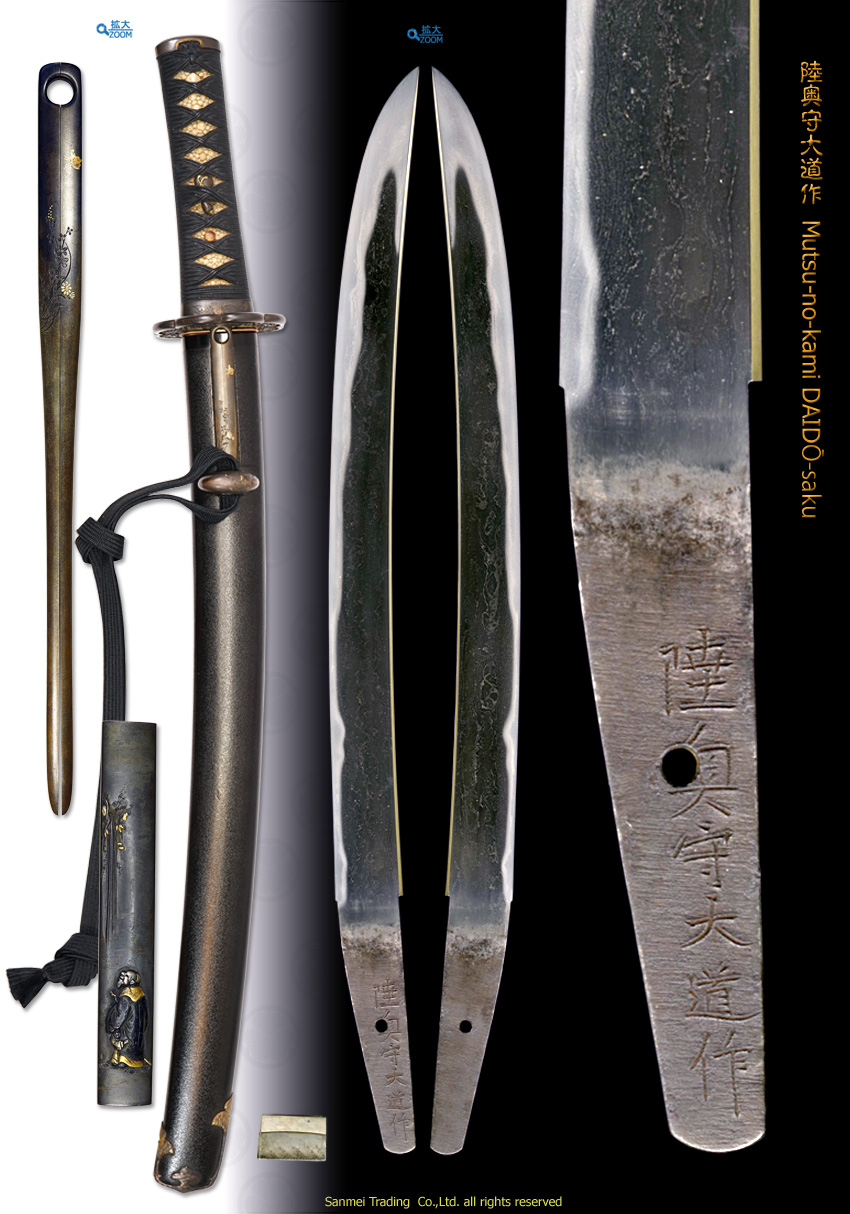with)Black Stone surface lacquered scabbard Chisa-katana Koshirae
Length of cutting edge 40.7cm Curvature 0.8cm Width of base 32.3mm Thickness of base 5.3mm
Forging(Hada): Forging is Itame mixing with Mokume where streaming Masame appears both on quenching area and the back side of Mune. Steel surface is covered with sparkling Ji-nie and Yubashiri that generates darkish Nie lines along Itame grain so called CHIKEI activity.
Temper(Hamon): Temper starts with a small Gunome "Yakidashi" upper the Hamachi, undulating Notare where is matching well on both sides of back and front. Upper the blade stronger the Nie and deeper the Nioi. Boundary line is getting more active with thick lines of Kinsen as well as some indication of Hotsure fray. The interior of temper is full of bright "Nioi" mist. The entire temper gives off the impression of dignified manner.
Temper of tip(Boshi): Temper of tip is irregular Miodarekomi, medium circle with Hakikake indication that turns back deeply.
Tang(Nakago): Nakago is in UBU original. slightly Slanting left (Kastte-sagari) file marks and the back ridge is flat with Katte-sagari filemarks as well. One Mekugiana peg hole. Double-bevelled (Kurijiri) heel shape.
The signature in front starts with an official district title granted by the Emperor Ōgimachi 正親町天皇 "Mutsu-no-kami" 陸奥守 and then smith name "DAIDŌ-saku" 大道作.
KANEMICHI 兼道 (later changed to DAIDŌ 大道), said as "the 9th generation of Shizu-saburo KANEUJI 志津三郎兼氏" has been renowned as the most superior maker who equals to KANETSUNE 兼常 and KANEFUSA 兼房 in Mino domain.
His posthumous works signed KANEMICHI 兼道 with the date of year ranges from Tenbun 16 (1547) to Eiroku 5 (1562).
From the reference of DAIDŌ-KI 大道記, he offered the dagger to Emperor Ōgimachi 正親町天皇 on Eiroku 12, Spring (1569) and was granted a word of "Ō" 大 (meining of "GREAT") from the Emperor and official district Mutsunokami 陸奥守 title by the Imperial Court.
He had put a honor word of "Ō" 大 prefixed to his smith name to be Ō-KANEMICHI 大兼道 only a couple of years during Genki era (1570-72) and then put an official title "Mutsunokami" 陸奥守 and changed his smith name as "DAIDŌ" 大道 on after Tensho 1 (1573). The posthumous works with the date of year as the inscription of Mutsunokami DAIDŌ 陸奥守大道 from Tensho 1 to 19 (1573-91).
The places of his studio, initially was in Seki town and later had moved to Gifu and he finally concluded to Kyoto as the founder of Mishina school during Bunrokuk era (1592-95) with his four sons Iganokami KINMICHI 伊賀守金道, Rai KINMICHI 来金道, Tanbanokami YOSHIMICHI 丹波守吉道 and Echunokami MASATOSHI 越中守正俊.
The subject Wakizashi shows the noble dignity during Azuchi-Momoyama period which was designed as a supplement fitting with long Tachi and DAIDŌ looked up Soushu works, especially ardently admired Hasebe's model from Nanbokucho period.
with) Black Stone surface lacquered scabbard Chisa-katana Koshirae consists of :
(click HERE for the entire Koshirae in FRONT, HERE for REVERSED side and HERE for higher resolution images for each metal fitting)
- Fuchi/Kashira : Autumn flowers Butterfly design, Shibuichi ground, polish surface, Gold, Yamagane copper Iroe
- Wari-kogai : Autumn flowers Butterfly design, Shibuichi ground, polish surface, Gold, Yamagane copper Iroe, signed NOBUSADA (seal) 信定(花押)
- Kozuka : scene of a poet RIHAKU contemplates waterfall, Shibuichi ground, polish surface, Gold, Yamagane copper Iroe
- Kurikata/Urakawara : Waterfall scene, Shibuichi ground, polish surface, Gold, Yamagane copper Iroe
- Menuki : design of slippery Gourd/sticky Soybeans Natto straw bag, Shibuichi ground, Katabori carving, Gold Iroe
- Tsuba : KIRI crest openwork design, Shibuichi ground, polish surface
- Tsuka : White rayskin, Black strings Jabara-style lozenge wrap
Recent polish/Condition scale: mint-excellent (using a scale of mint-excellent-very good-good-fair-poor).
reference data:
Suzuki Takuo/Sugiura Yoshiyuki Muromachi-ki Mino Toko-no Kenkyu Ribun Shuppan 2006




